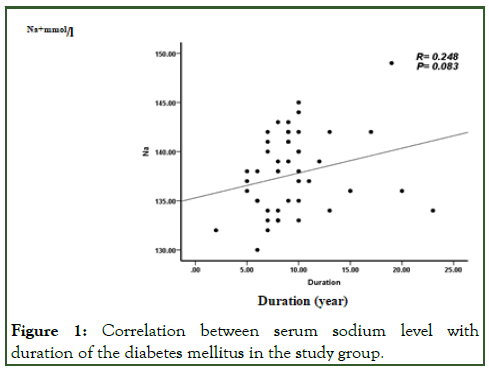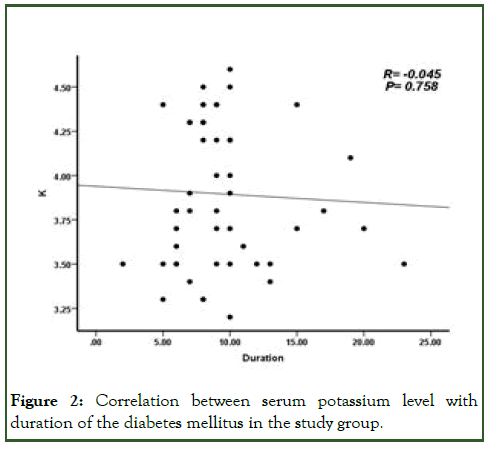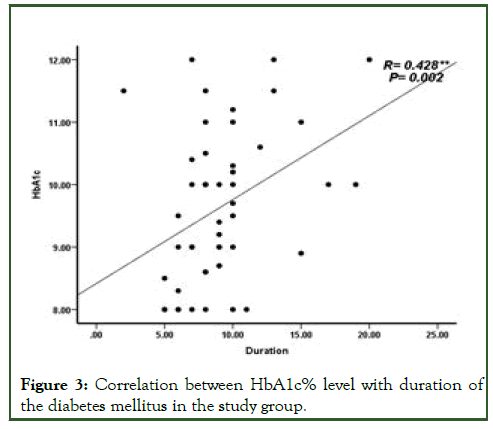Indexed In
- Euro Pub
- Google Scholar
Useful Links
Share This Page
Journal Flyer

Open Access Journals
- Agri and Aquaculture
- Biochemistry
- Bioinformatics & Systems Biology
- Business & Management
- Chemistry
- Clinical Sciences
- Engineering
- Food & Nutrition
- General Science
- Genetics & Molecular Biology
- Immunology & Microbiology
- Medical Sciences
- Neuroscience & Psychology
- Nursing & Health Care
- Pharmaceutical Sciences
Research Article - (2024) Volume 8, Issue 3
Assessment of Serum Electrolyte Levels and HbA1C Levels among Type 2 Diabetic Sudanese Patients with Macrovascular Complications in Khartoum State
Ragda Hafaz Ramadan and Abdulmwla Muhammed Abdullah*Received: 23-Jan-2020, Manuscript No. JCMS-24-3197; Editor assigned: 28-Jan-2020, Pre QC No. JCMS-24-3197 (PQ); Reviewed: 11-Feb-2020, QC No. JCMS-24-3197; Revised: 01-Jul-2024, Manuscript No. JCMS-24-3197 (R); Published: 29-Jul-2024, DOI: 10.35248/2593-9947.24.8.2943
Abstract
Background: Recently epidemiological studies have shown that type 2 diabetes mellitus is great a risk factor for cardiovascular mortality. Electrolyte abnormalities are commonly encountered in chronic diabetes mellitus type 2 patients.
Aim: The aim of this study was to estimate serum electrolyte levels and HbA1C levels among Sudanese diabetic patients with macrovascular complications in Khartoum state, Sudan.
Materials and methods: in this case control hospital based study conducted in, Khartoum state. Hundred subjects were involved, fifty were type 2 diabetes patients and fifty healthy subjects control group sex and age matched. Serum Na and K levels estimated by automated biochemistry analyzer (Easylyte electrolyte) and HbA1C by automated biochemistry analyzer.
Result: The mean serum level of sodium and potassium in type 2 diabetes patients were significantly decreased (137.7 ± 4.05 vs. 139.8 ± 3.62 mmol/l, p=0.008 and 3.60 ± 0.20 vs. 3.92 ± 0.22 mmol/l, p=0.03 respectively ). Where as HA1C level showed significant increases in the test group when compared with reference group (9.68 ± 1.24 vs. 5.44 ± 0.42%, P=0.000). Across gender our study observed no significant alteration in serum Na and K levels (p>0.05) in type 2 diabetic patients. Furthermore serum Na+ level was significantly correlated K+ (R=0.369, p=0.008). Where as both Na+ and K+ were in significantly correlated with patients age, HbA1c (%) and duration of DM (p>0.05). In contrast HA1C is significantly correlated with the duration of diabetes (R-=0.425, P=0.002).
Conclusion: Our study revealed significant alterations in electrolyte levels in type 2 diabetes mellitus and proper hyperglycemic control with evaluation of electrolyte levels can reduce the complication accompanied with electrolyte disbalance in type2 DM.
Keywords
Electrolyte; HbA1C; Sodium; Potassium; Macro vascular complications, Sudanese
Introduction
Diabetes is a major worldwide health problem. Diabetes mellitus is an endocrine disorder affecting millions of people every year. Diabetes remains latent and its secondary complications leads to the mortality and morbidity [1]. Type 2 diabetes mellitus is a common chronic disease of adults, which presents with acute, sometimes life-threating, symptomatic hyperglycemia [2]. Serious long-term complications associated to type 2 diabetes include cardiovascular disease, stroke, chronic kidney disease, foot ulcers and damage to the eyes. Recently epidemiological studies have shown that type 2 diabetes mellitus is great a risk factor for macrovascular mortality [3].
There is a strong relation between electrolytes and T2DM. Electrolytes play an important role in maintaining acid-base balance, blood clotting, control body fluid and muscle contractions. The electrolytes in serum include sodium (Na+), potassium (K+), calcium (Ca2+) and magnesium (Mg2+) [4].These electrolytes play an important role in intermediary metabolism and cellular function, including enzyme activities and electrical gradients. Serum concentrations of electrolytes have been shown to change with plasma glucose levels [5]. Disturbed electrolyte distribution may affect the course of diabetes and its management. The relation between blood glucose and electrolytes is complex and is related to a number of other factors like age and associated conditions [6]. Glucose is an osmotically active substance and hyperglycemia increases serum osmolality and results in movement of water out of the cells and reduction of sodium levels by the dilutional effect. The osmotic effect of glucose also causes osmotic diuresis causing a decrease in circulating blood volume and cellular dehydration due to the shift of water from intracellular spaces causing cellular dehydration [8].
Glycosylated hemoglobin (HbA1c) is the most vital target of glycemic control. The desirable value for HbA1c is values below 6.0%. HbA1c is important standard in analysis of patients’ status that indicates the average blood glucose during the past three months which is essential to ensure the optimal care of diabetic patients [9,10]. The research has revealed that with each one percent reduction in the value of HbA1c, the risk of micro vascular complications is reduced by 40 percent. This study carried to measured serum electrolyte levels and HbA1C and examined their relationship with macrovascular complications in Sudanese adults with diabetes.
Materials and Methods
Study design and population
This is case-control study was performed at Asia hospital- Khartoum state during May to December 2019, including hundred subjects, fifty patients known diagnosed with diabetes mellitus type 2 (26 (52%) females and 24 (48%) males), with mean age 55.5 ± 8.11 year and duration of diabetes 2.00-23.0 years and other fifty healthy individuals as control groups sex and age matched.
Inclusion criteria
Sudanese patients diagnosed with type 2 diabetes mellitus with age more than 40 years and less than 70 years.
Exclusion criteria
Patients who had type 1 diabetes mellitus, known malignancy infectious disease and any type 2 diabetic patients refuse to participate in this study were excluded.
Data collection and clinical examination
Each site used a standardized questionnaire which collected the demographic and symptom information assessed in this study.
Sample collection
Blood was taken from each participant by standard procedures. Plasma sodium (Na+) and potassium (K+), were estimated by ion selective electrode method in fully automated biochemistry analyzer (easylyte electrolyte). HbA1C was estimated by enzymatic method in fully automated biochemistry analyzer.
Quality control
Samples representing the normal and pathological levels of sodium, potassium and HA1C were used for assessment of the quality control. Results ± 2 SD of the target values of the control sera were accepted.
Statistical analysis
Data was analyzed by computer software by using SPSS program manual master sheet (SPSS version 21), the results were expressed as frequency percentage, mean and SD and the independent t-test was used to compare the mean levels of sodium, potassium and HA1C in case and control. Correlation between measured variable was significant at p ≤ 0.05.
Results
A total of 100 subjects were included for the study. All subjects categorized in two groups, 50 patients with type 2 diabetes mellitus case (26 (52%) females and 24 (48%) males) [7]. With mean age 55.5 ± 8.11 years and duration of diabetes 2.00-23.0 years. In addition to other 50 healthy subjects age and sex matched control group in Table 1.
| Variables | Minimum | Maximum | Mean ± SD |
|---|---|---|---|
| Age (year) | 40 | 70 | 55.5 ± 8.11 |
| Duration (year) | 2 | 23 | 9.44 ± 3.97 |
Table 1: Mean age and duration of diabetes mellitus in the study group.
As presented in Table 2 the mean serum level of both sodium and potassium in type 2 diabetes patients were significantly decreased when compared to the control group (137.7 ± 4.05 vs. 139.8 ± 3.62 mmol/l, p=0.008 and 3.60 ± 0.20 vs. 3.92 ± 0.22 mmol/l, p=0.03 respectively), whereas HA1C level showed significant increases in the test group when compared with reference group (9.68 ± 1.24 vs. 5.44 ± 0.42%, P=0.000 and with significant elevation of both systolic and dystolic blood pressure (p=0.000).
| Parameters | Case (Mean ± SD) | Control (Mean ± SD) | P-value |
|---|---|---|---|
| Na+ (mmol/L) | 137.7 ± 4.05 | 139.8 ± 3.62 | 0.008 |
| K+ (mmol/L) | 3.60 ± 0.20 | 3.92 ± 0.22 | 0.03 |
| HbA1c (%) | 9.68 ± 1.24 | 5.44 ± 0.42 | 0 |
| SPB (mmHg) | 133.0 ± 3.73 | 120.6 ± 0.86 | 0 |
| DBP (mmHg) | 88.70 ± 2.38 | 80.52 ± 1.63 | 0 |
Table 2: Mean comparison of study parameters in case versus control group.
As illustrated in Table 3, across gender there is no significant differences in serum Na+ and K+ levels in males when compared with females (p>0.05) in type 2 diabetic patients [9].
| Parameters | Male (Mean ± SD) | Female (Mean ± SD) | P-value |
|---|---|---|---|
| Na+ (mmol/L) | 137.0 ± 3.39 | 138.3 ± 4.55 | 0.258 |
| K+ (mmol/L) | 3.79 ± 0.38 | 3.99 ± 0.40 | 0.068 |
| HbA1c (%) | 9.48 ± 1.18 | 9.87 ± 1.29 | 0.258 |
| SPB (mmHg) | 133.6 ± 3.75 | 132.4 ± 3.68 | 0.259 |
| DBP (mmHg) | 88.6 ± 2.22 | 88.76 ± 2.57 | 0.833 |
Table 3: Mean comparison of study parameters in male versus female in the study group.
In Table 4, serum Na+ level was significantly correlated with K+ (R=0.369, p=0.008). Where as both serum Na+ and K+ were in significantly correlated with both patients age and HbA1c (%) (p>0.05) in the study group [10].
| Variables | Na+ (mmol/L) | K+ (mmol/L) | HbA1c (%) | |
|---|---|---|---|---|
| Age | R | 0.241 | 0.1 | 0.378 |
| P | 0.09 | 0.49 | 0.007 | |
| Duration of DM | R | 0.248 | 0.045 | 0.425 |
| P | 0.08 | 0.758 | 0.002 | |
| Na+ (mmol/L) | R | - | 0.369 | 0.175 |
| P | - | 0.008 | 0.225 | |
| K+ (mmol/L) | R | 0.369 | - | 0.061 |
| P | 0.008 | - | 0.675 | |
| HbA1c (%) | R | 0.175 | 0.061 | |
| P | 0.225 | 0.675 | ||
Table 4: Correlation between Na+, K+, HbA1c (%) and with patients age in the study group.
As shown in Figures 1 and 2 both serum K+ recorded insignificant correlation with duration of diabetes mellitus (R=0.248, P=0.08 and R=0.045, P=0.758 respectively) in the study group, whereas HA1C is significantly correlated with the duration of diabetes (R-=0.425, P=0.002) in Figure 3 [11].

Figure 1: Correlation between serum sodium level with duration of the diabetes mellitus in the study group.

Figure 2: Correlation between serum potassium level with duration of the diabetes mellitus in the study group.

Figure 3: Correlation between HbA1c% level with duration of the diabetes mellitus in the study group.
Discussion
Type 2 diabetic individuals are at higher risks of serious longterm complications associated with type 2 diabetes include cardiovascular disease, stroke, chronic kidney disease, foot ulcers and damage to the eyes. Electrolytes play an important role in several body mechanisms and electrolyte imbalance is commonly present in patients with type 2 diabetes mellitus, the cause is usually multifactorial, but commonly results from insulin inactive or deficiency.
In the current study mean serum level of sodium and potassium were significantly decreased in type 2 diabetes patients Which are inconsistence with the studies performed by Nabil, et al., and Ugwuja, et al. and disagree with Sarguru, et al. and McDonnell et al. Another studies conducted by Rashid, et al. and Alaka and Saurabh observed that Serum Na+ was significantly low and serum Cl-, Ca2+ were significantly increased in type 2 DM compared to control. Insignificant high value of serum K+ was observed in case compared to control. Wang, et al., reported only 0.6% of diabetes had hypokalemia and 1.2% of diabetes subjects had hyperkalemia. George, et al., perform an overview on electrolyte levels in type 2 diabetic patients and observed that diabetic patients frequently develop a constellation of electrolyte disorders.
Across gender our study recorded insignificant alteration in serum Na and K levels (p>0.05) in type 2 diabetic patients.
The present study illustrated significant correlation between serum Na+ and K+ levels (p<0.05). Whereas both Na+ and K+ were in significantly correlated with patients age, HbA1c (%) and duration of DM (p>0.05).
Our study observed significant increases in HA1C level in the test group when compared with reference group, with significant correlation with the duration of diabetes (P=0.002). Elevated level of HA1C-reflects uncontrolled DM which induced osmotic diuresis, that may increase the urinary excretion of Na+ and K+. It’s proposed to be a primary mechanism responsible for the decreased serum concentrations of Na+ and K+.
Conclusion
Sodium and potassium imbalance is significantly present in patients with uncontrolled diabetes mellitus, hence electrolytes levels should be routinely determined in patients with type 2 diabetes mellitus.
Acknowledgement
We thank all the study participants and we acknowledge the support of the staff of Asia hospital-Khartoum state, who provided the facilities for the interviews and the laboratory work.
Ethical Consideration
Ethical approval was taken from Elneelain university research council and written consent was obtain from all participants in this study.
References
- Lobo DN. Fluid, electrolytes and nutrition: Physiological and clinical aspects. Proc Nutr Soc. 2004;63(3):453-466.
[Crossref] [Google Scholar] [PubMed]
- Rao GM. Serum electrolytes and osmolality in diabetes mellitus. Indian J Med Sci. 1992;46(10):301-303.
[Google Scholar] [PubMed]
- Shahid SM, Rafique RO, Mahboob TA. Electrolytes and sodium transport mechanism in diabetes mellitus. Pak J Pharm Sci. 2005;18(2):6-10.
[Google Scholar] [PubMed]
- Harris MI, Flegal KM, Cowie CC, Eberhardt MS, Goldstein DE, Little RR, et al. Prevalence of diabetes, impaired fasting glucose and impaired glucose tolerance in US adults: The third national health and nutrition examination survey, 1988-1994. Diabetes Care. 1998;21(4):518-524.
[Crossref] [Google Scholar] [PubMed]
- Barbagallo M, Dominguez LJ, Resnick LM. Magnesium metabolism in hypertension and type 2 diabetes mellitus. Am J Ther. 2007;14(4):375-385.
[Crossref] [Google Scholar] [PubMed]
- Liamis G, Rodenburg EM, Hofman A, Zietse R, Stricker BH, Hoorn EJ. Electrolyte disorders in community subjects: Prevalence and risk factors. Am J Med. 2013;126(3):256-263.
[Crossref] [Google Scholar] [PubMed]
- Rohlfing CL, Little RR, Wiedmeyer HM, England JD, Madsen R, Harris MI, et al. Use of GHb (HbA1c) in screening for undiagnosed diabetes in the US population. Diabetes Care. 2000;23(2):187-191.
[Crossref] [Google Scholar] [PubMed]
- Khaw KT, Wareham N, Luben R, Bingham S, Oakes S, Welch A, et al. Glycated haemoglobin, diabetes and mortality in men in Norfolk cohort of European Prospective Investigation of Cancer and Nutrition (EPIC-Norfolk). BMJ. 2001;322(7277):15.
[Crossref] [Google Scholar] [PubMed]
- Kesaniemi YA, Grundy SM. Increased low density lipoprotein production associated with obesity. Arteriosclerosis.. 1983;3(2):170-177.
[Crossref] [Google Scholar] [PubMed]
- McDonnell CM, Pedreira CC, Vadamalayan B, Cameron FJ, Werther GA. Diabetic ketoacidosis, hyperosmolarity and hypernatremia: Are high‐carbohydrate drinks worsening initial presentation? Pediatr Diabetes. 2005;6(2):90-94.
[Crossref] [Google Scholar] [PubMed]
- Khan RN, Saba F, Kausar SF, Siddiqui MH. Pattern of electrolyte imbalance in type 2 diabetes patients: Experience from a tertiary care hospital. Pak J Med Sci. 2019;35(3):797.
[Crossref] [Google Scholar] [PubMed]
Citation: Ramadan RH, Abdullah AM (2024) Assessment of Serum Electrolyte Levels and HbA1C Levels among Type 2 Diabetic Sudanese Patients with Macrovascular Complications in Khartoum State. J Clin Med Sci. 8:285.
Copyright: © 2024 Ramadan RH, et al. This is an open-access article distributed under the terms of the Creative Commons Attribution License, which permits unrestricted use, distribution, and reproduction in any medium, provided the original author and source are credited.
